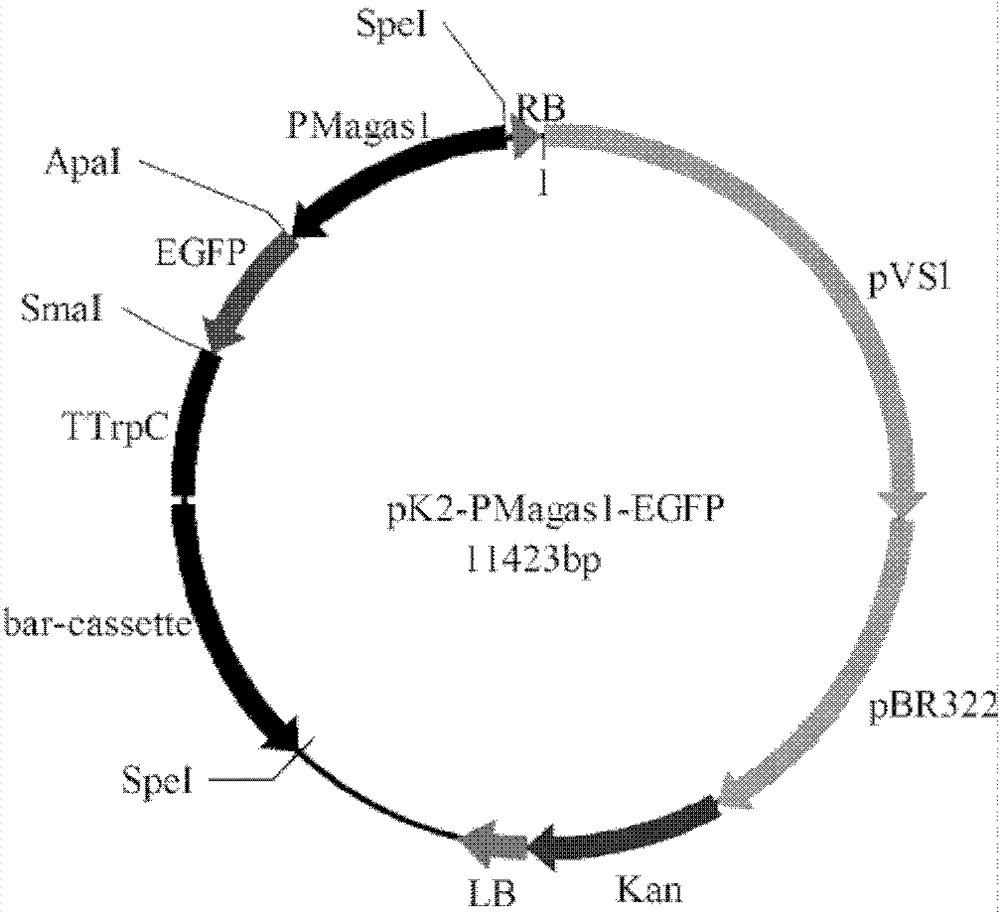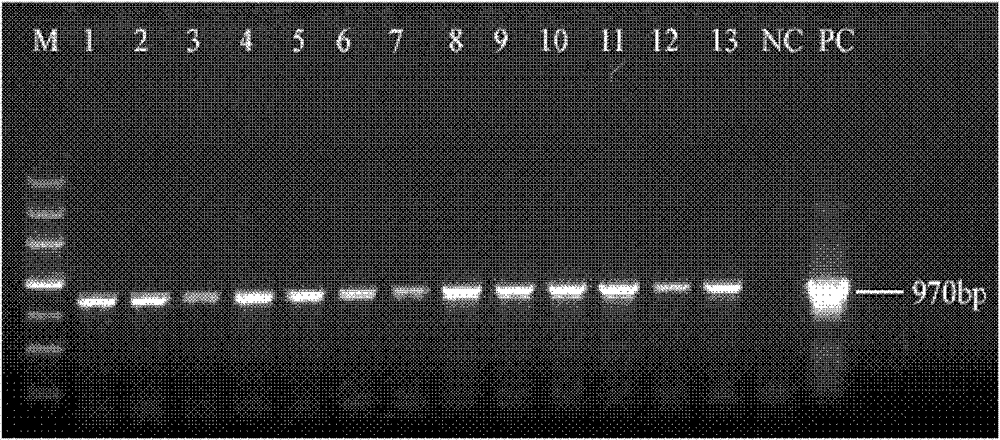Specific promoter of pathogenic filamentous fungi and use thereof
A technology of filamentous fungi and promoters, applied to fungi, using vectors to introduce foreign genetic material, microorganisms, etc., can solve the problem of gene regulation without reporting
- Summary
- Abstract
- Description
- Claims
- Application Information
AI Technical Summary
Problems solved by technology
Method used
Image
Examples
Embodiment 1
[0022] Example 1: Isolation of promoters
[0023] The strain used in the present invention is Metarzhizium acridum strain CQMa102. Get the CQMa102 bacterial strain 10 that is cultivated on 1 / 4SDAY medium (glucose 10g / L, peptone 2.5g / L, yeast extract 5.0g / L, agar 18g / L, pH value is adjusted to 6.0). 5 Each spore was inoculated in 1.5ml 1 / 4SDAY liquid medium, cultured with shaking at 28°C at 250rpm for 3 days, and genomic DNA was extracted with a fungal gene DNA extraction kit (Bioflux, Hangzhou).
[0024] The cloned Magas1 gene sequence was compared with the existing Metarhizium anisopliae genome sequence to obtain the partial sequence upstream of the Magas1 gene, analyzed by the promoter prediction software, intercepted a sequence of 1222bp, and designed the primer PMagas1F5'CG Actagt TTGTACGGAGTACTCCAG ACGT3' (contains SpeI restriction site) and PMagas1R5'CA ggggccc GGATAAGGTAGGGGGTTTTGTA3' (contains ApaI restriction site). The extracted genomic DNA was used as a templat...
Embodiment 2
[0025] Embodiment 2: PMagas1-EGFP expression vector construction
[0026] Design primer EGFPF5'AT according to EGFP sequence ggggccc ATGGTGAGCAAGGGCGAGG3' (the underline is the ApaI restriction site) and EGFPR5'CA cccggg TTACTTGTACAGCTCGTCC3' (the underline is the SmaI restriction site), the EGFP sequence was amplified from the pEGFPN-1 plasmid (BD, USA), and the correctness of the sequence was verified by sequencing. The EGFP amplified product was cut with ApaI and SmaI and then inserted into PDPB-PMagas1 cut with ApaI and SmaI. Construction of PDPB-PMagas1-EGFP vector. After transformation of E. coli, plasmids were extracted. Use SpeI to cut the PDPB-PMagas1-EGFP vector, cut out the expression element PMagas1-EGFP, insert it into the pK2 vector containing Bar resistance, and construct the pK2-PMagas1-EGFP expression vector. The vector pattern is as follows figure 1 shown.
Embodiment 3
[0027] Embodiment 3: Transformation and identification of Metarhizium anisopliae with PMagas1-EGFP expression vector
[0028] The PMagas1-EGFP expression vector was transformed into Agrobacterium tumefaciens EAH105 strain (Beijing Dingguo) by electrotransformation, and then verified by PCR. Through the Agrobacterium-mediated method (Fang, W., Zhang, Y., Yang, X., Zheng, X., Duan, H., Li, Y., Pei, Y., 2004.Agrobacterium tumefaciens-mediated transformation of Beauveria bassiana using an herbicide resistance gene as a selection marker. J Invertebr Pathol 85, 18-24), transform Metarhizium anisopliae CQMa102. On Chase medium containing 80 μg / ml herbicide (sucrose 30g / L, NaNO 3 2g / L, KH 2 PO 4 1g / L, MgSO 4 0.5g / L, KCl 0.5g / L, FeSO 4 0.01g / L, agar 15g / L) to screen transformants. After culturing for 10 days, the transformants were selected and cultured on 1 / 4SDAY, the genomic DNA of the transformants was extracted with a fungal gene DNA extraction kit (Bioflux, Hangzhou), an...
PUM
 Login to View More
Login to View More Abstract
Description
Claims
Application Information
 Login to View More
Login to View More - Generate Ideas
- Intellectual Property
- Life Sciences
- Materials
- Tech Scout
- Unparalleled Data Quality
- Higher Quality Content
- 60% Fewer Hallucinations
Browse by: Latest US Patents, China's latest patents, Technical Efficacy Thesaurus, Application Domain, Technology Topic, Popular Technical Reports.
© 2025 PatSnap. All rights reserved.Legal|Privacy policy|Modern Slavery Act Transparency Statement|Sitemap|About US| Contact US: help@patsnap.com



